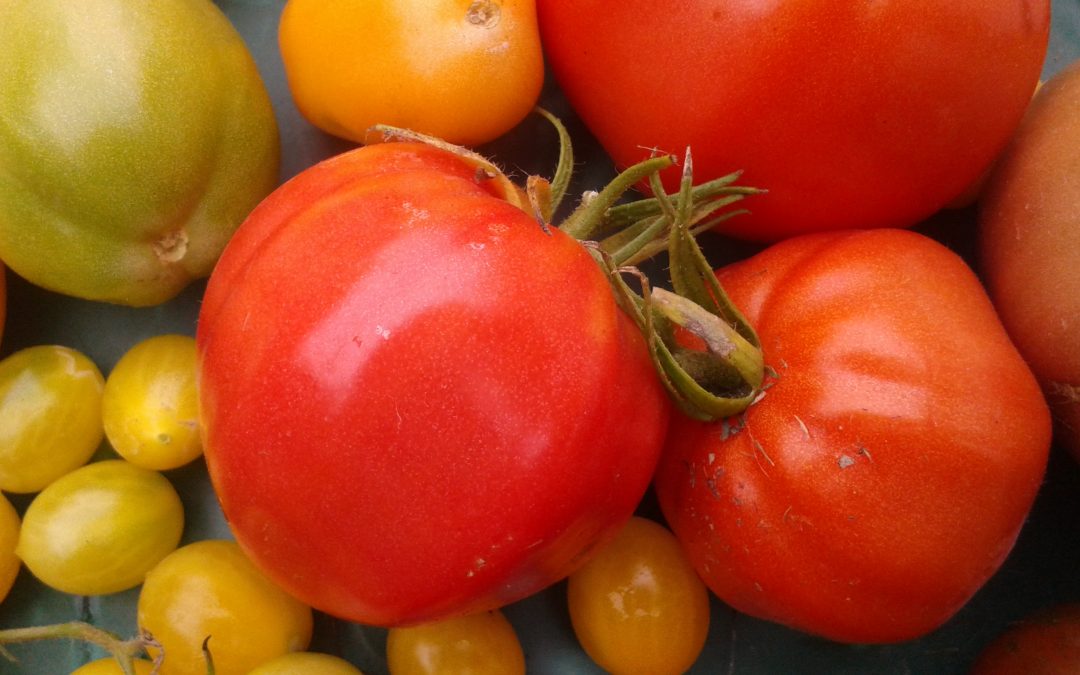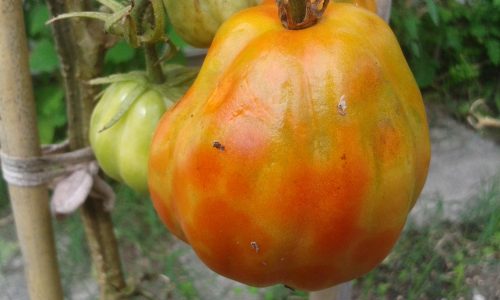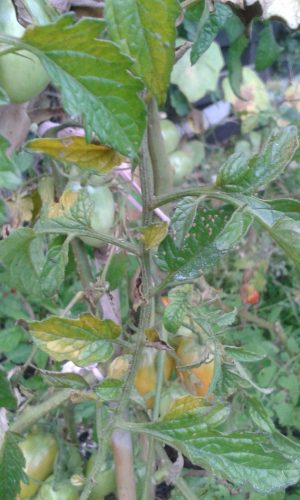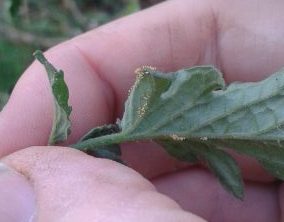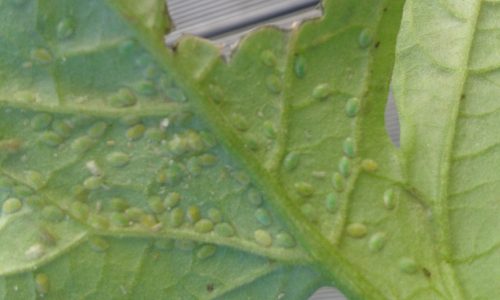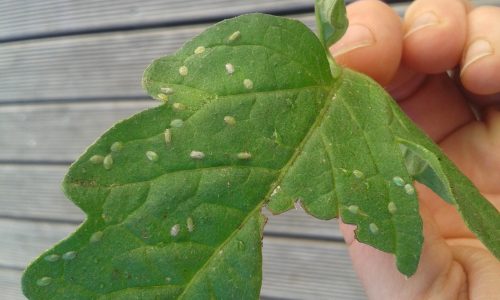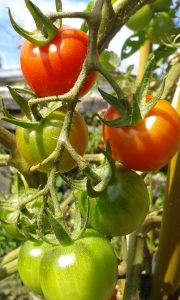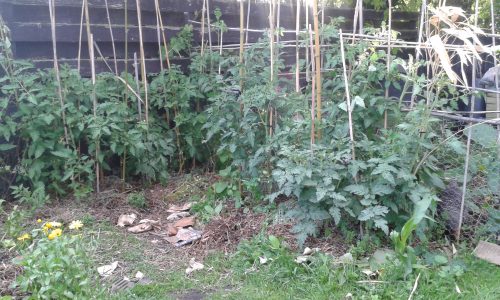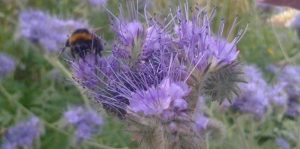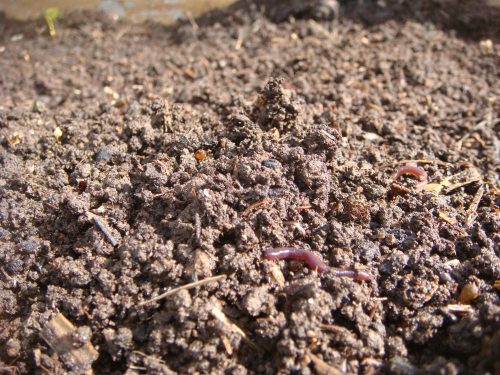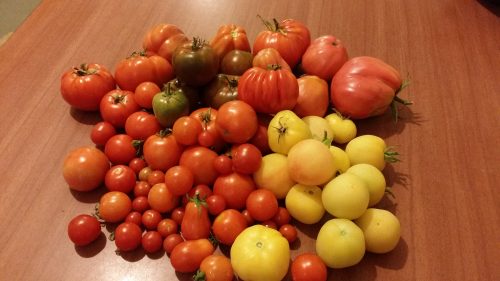The psyllid is soon to be making an appearance. Get your prevention and maintenance plan in place to ensure your beloved plants don’t get destroyed by this rampant pest.
Photo from Whitney Cranshaw. Bugwood.org
What is the tomato potato psyllid?
The tomato potato psyllid (TPP/Bactericera Cockerelli) is a small insect that lives on all members of the Solanaceae Family. This includes Tomatoes, Potatoes, Peppers, Capsicums, Cape Gooseberry and Tamarillo.
The TPP is a summer pest which causes havoc in the vegetable garden sucking the life out of plants and the fruits they bear.
Psyllid damage on tomato fruit
TPP infested potato plants may end up with little to no crops. If you do manage a harvest, many of the potatoes are mushy and watery with distinct brown markings when you slice them open.
Infested tomatoes end up watery and tasteless with discoloured blotches on the skin. Instead of being uniform red on the inside, a sliced tomato will have a white circle around the edge.
Psyllid damage on leaves with nymphs visible
The life of the psyllid
Learn to recognise the psyllid so you can take control measures and avoid plague proportions. Understanding how to identify the different parts of it’s life cycle. If you get them early on your have more chance of saving your plants.
The psyllid starts off life as an egg. These are tiny and yellow and laid along the edges of the leaves.
Psyllid eggs all along the edge of a tomato leaf
It then becomes a nymph and looks similar to scale. They do not yet have wings and move slow so are easily squashed. You can reduce numbers rapidly at this stage by squashing and removing leaves covered in nymphs.
Psyllid Nymphs
The nymphs begin to look white as they grow wings and eventually turn black. An adult psyllid is the size of an aphid and looks a little like a miniature cicada. They have a white band across their back which makes them distinguishable to an aphid.
Nymphs turning into young adults
Keep an eye out for a white sticky powder on top of the leaves. This is the “sugars” that the psyllid excrete after sucking the life out of your plants and a good clue to their presence.
Prevention better than cure
Always, always start with the healthiest plants you can grow or buy. Check all plants for pests when buying from garden stores and large DIY home stores. I found chilli plants riddled in psyllid at one store years ago. After mentioning it to the store owner they said they would just spray them. Great! Pest riddled, chemically sprayed weak plants. Just what I want.
Choose quality seed grown in New Zealand. Healthy tomato and potato seeds will have better resistance to the psyllid to begin with. For the past 3 years, we have been saving tomato seeds from plants that are less effected by TPP in order to create resilient tomato seed lines. Tommy Toe and Riverside Market seem to be the strongest plants and they are available in our catalogue.
Tommy Toe Tomato
Cover crops with mesh
Mesh crop greatly reduces TPP damage and also prevents blight, particularly in potatoes. Cover your crops in mesh like the one available from The Biological Husbandry Unit (BHU) at Lincoln University. Recent BHU field trials showed higher yields and increased profits when growing potatoes with mesh cloth compared with the best commercial agrichemical regime. This is great news for those wanting to move away from chemical inputs to a more sustainable and biological system.
Weekly psyllid maintenance
In summer I spend an hour each week inspecting my tomato plants for psyllid. This is time well spent as each year I have had great tomato harvests despite the presence of psyllid. I squash the adults (they move quickly so act fast) and remove all leaves covered in nymphs. Infested leaves are put into a black bin bag which is tied up and left in the sun for a week. This kills everything before it goes out for rubbish collection. Do not ever compost disease and pest infected plants.
The psyllid flies low (this is one of the reasons the mesh cover works well) and can always be found on the bottom leaves of the plant first. In particular it hides on those leaves which are out of human sight. Be sure to look right into the middle of your tomato patches. They are sneaky!
Healthy tomato plants despite having psyllid
Manual removal of the psyllid dramatically decreases their numbers. The sooner you start reducing numbers the better. If a plant is completely infested and without much fruit I remove it altogether.
Increase diversity
Nature can be a big help when it comes to reducing pest infestations in our gardens. Lacewings, ladybirds, hoverflies and their larvae will happily feast on psyllid nymphs and adults. Attract them into your garden by planting phacellia, buckwheat and by letting a few plants go to seed. For more ideas on attracting beneficials into your garden download my free guide.
The EPA has approved the release of a natural predator wasp to the psyllid Tamarixia triozae. Unlike regular wasps predatory wasps are tiny and they lays their eggs inside the nymphs ultimately killing them when the larvae eats their way our. Tasty!
My feeling is that the release of this wasp will only work if we are providing the right habitat for them to survive. This means increasing the amount of beneficial plants and flowers in your garden!
Feed, feed and feed some more
I cannot stress enough how important it is to feed your tomato and potato plants every week throughout the summer season. This will ensure that your plants are getting the nutrients they need to withstand these pest attacks. Weak plants are more susceptible to pest invasion so create a routine of liquid feeding. You can make your own liquid fertilisers or buy them from a garden shop. I like to use the Reproductive Foliar from Environmental Fertilisers, it promotes more fruit on your plants and also keeps them healthy.
Managing psyllid with natural insecticides
This is a last resort for me and to date I have not used any of these on my tomatoes. Some may deem it necessary to save their plants. Like any pesticide we put on our plants it is best to exercise caution and consider the effect on the bigger picture. None of these solutions entirely discriminate beneficial bugs so always use in the evening and remember less is more.
I have heard success stories like those of Kath Irvine where Psyllid numbers have been reduced drastically using Neem. Neem Oil is a low-toxicity botanical pesticide prepared from the Neem Tree (Azadirachta indica). It works in several ways disrupting the reproductive cycle of the psyllid, including the development from nymph to adult and deterring the female from laying eggs.
Diatomaceous earth is another natural choice which contains no toxic poisons. Made of fine silica, it basically rips apart the joints and internal breathing structure of the insect. Dust lightly and evenly over vegetable crops wherever adults are found.
Both of these solutions can be applied on a weekly or fortnightly basis depending on the intensity of your situation.
A new generation of biological pesticides
This is an exciting new area of research and development and one which works in with nature and supporting diversity in the soil. Biological pathogens present the least environmental risk to beneficial insect and soil life. They work by populating the soil with beneficial life which then competes with plant pathogens helping to create healthy soil plant balance. My dad purchased some Combo-12 awhile back and gave me some to try. This year I am trying it for the first time so I will let you know how that goes!
While the TPP can be devastating, don’t let it stop you from growing tomatoes or potatoes. If you make a plan to maintain your crops through regular feeding, good soil health and removal of the pest, you can still get a decent crop!
Last year we harvested over 30kilos of tomatoes despite having the TPP.
For more information on the TPP check out Landcare research.
If you are need more tips for dealing with Pest and Disease naturally in the home garden then download our FREE guide below.

